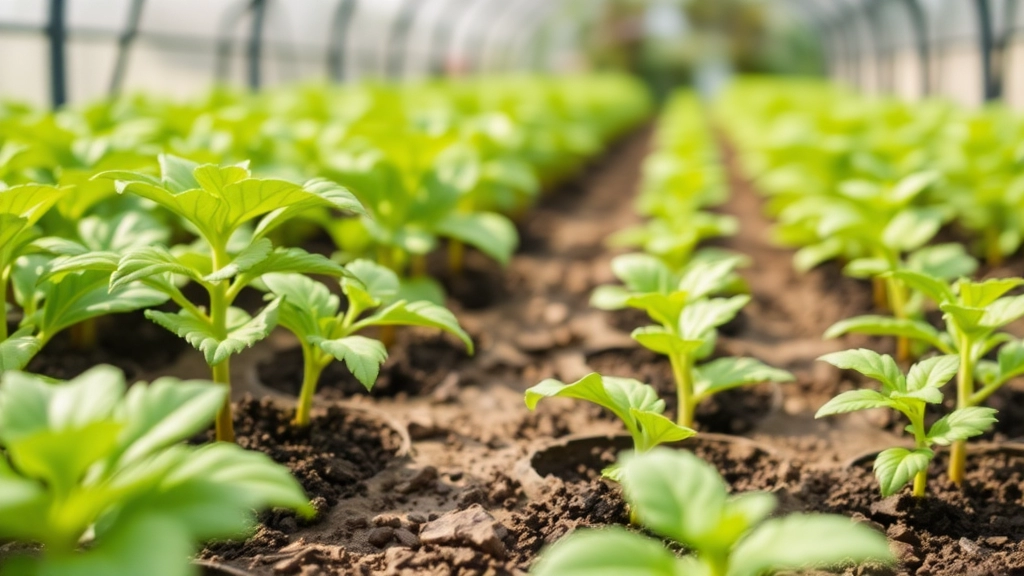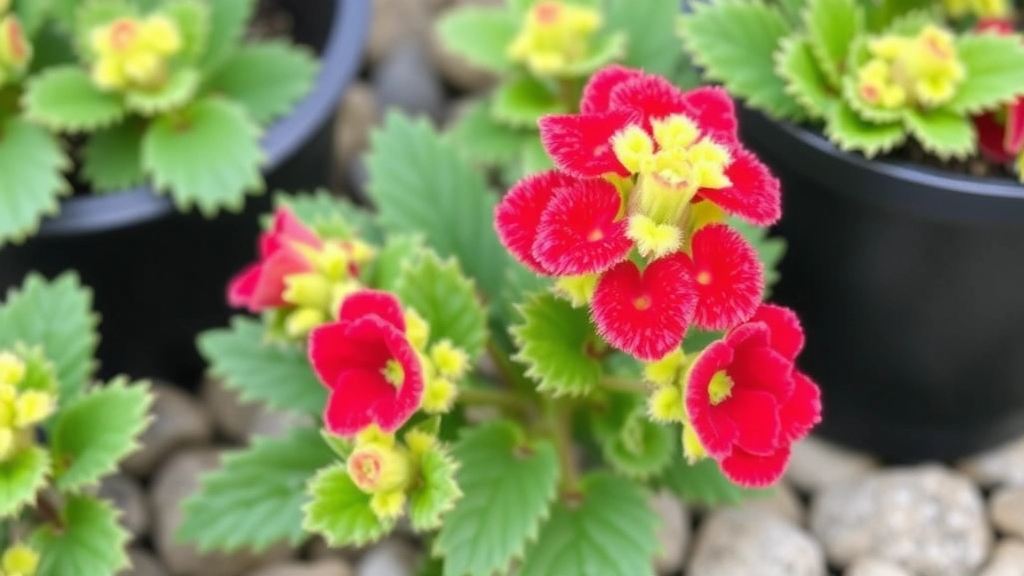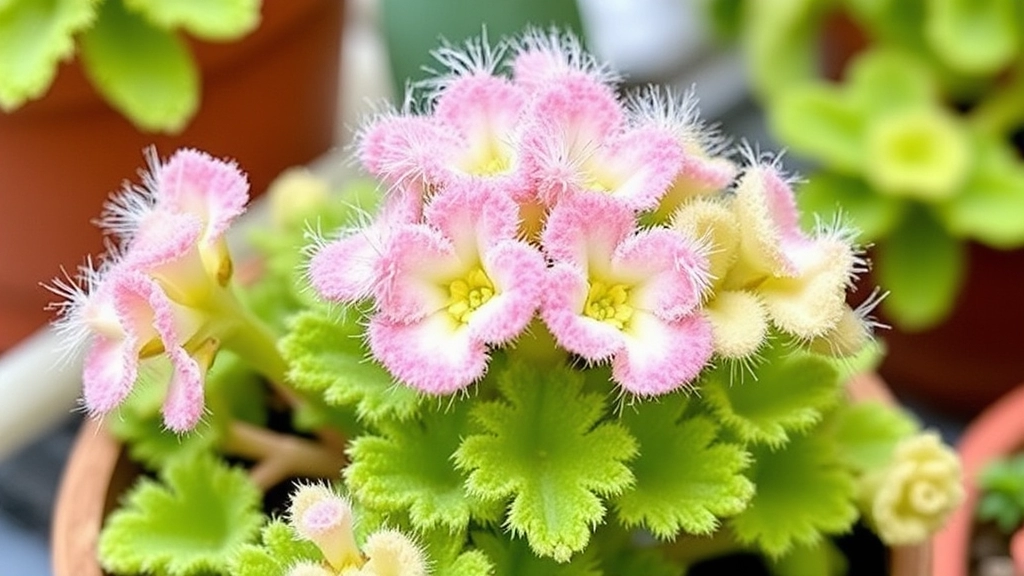Guide to Caring for Fuzzy Kalanchoe Plants
If you’ve ever stumbled upon a fuzzy Kalanchoe plant, you know just how captivating they can be. These charming succulents, with their soft, velvety leaves, are not only a joy to look at but also relatively easy to care for. In this guide, I’ll share some straightforward tips to help you keep your fuzzy Kalanchoe thriving.
Light Requirements
First, let’s talk about light. Fuzzy Kalanchoe plants love bright, indirect sunlight. Too much direct sun can scorch their delicate leaves, while too little light can make them leggy.
Watering Tips
Next, water them sparingly. These plants are succulents, so they store water in their leaves. Overwatering can lead to root rot, so it’s best to let the soil dry out completely between waterings.
Soil Considerations
Finally, a well-draining potting mix is a must. This ensures excess water doesn’t sit around the roots, keeping your plant healthy and happy.
Characteristics of the Fuzzy Kalanchoe Plant
Are you curious about what makes the Fuzzy Kalanchoe plant stand out?
The Fuzzy Kalanchoe, scientifically known as Kalanchoe tomentosa, is a delightful succulent that boasts unique features.
Distinctive Features
- Fuzzy Leaves: One of the most striking characteristics is its velvety, fuzzy leaves. These leaves are covered in fine hairs, giving them a soft texture that is both appealing and unusual.
- Shape and Colour: The leaves are typically oval-shaped and can vary in colour from green to a silvery hue, often displaying a reddish edge. This colour variation adds an extra layer of interest to the plant.
- Growth Habit: Fuzzy Kalanchoe tends to grow upright and can reach a height of about 30 cm (12 inches). Its compact form makes it an excellent choice for small spaces.
- Flowers: While primarily grown for its foliage, the plant can produce clusters of small, tubular flowers, usually in a pale yellow or orange shade. These blooms can be a charming surprise, although they are not the main attraction.
Understanding these characteristics helps you appreciate the unique beauty of the Fuzzy Kalanchoe. For more detailed information, you might want to check out the top fuzzy Kalanchoe types for your garden and a complete guide on how to care for Kalanchoe tomentosa.
Ideal Growing Conditions

So, you’ve got your eye on the fuzzy Kalanchoe plant, huh? Great choice! But before you dive in, let’s chat about where this beauty thrives best.
Light Requirements
Fuzzy Kalanchoes love bright, indirect sunlight.
- Ideal Spot: A south or east-facing window is perfect.
- Too Much Sun: Direct sunlight can scorch those lovely leaves.
- Not Enough Light: If the leaves start to stretch, they’re begging for more light.
Temperature and Humidity
These plants are pretty chill when it comes to temperature.
- Optimal Range: They prefer temperatures between 18°C to 24°C (65°F to 75°F).
- Avoid Frost: They’re not fans of cold, so keep them away from chilly drafts.
- Humidity: Normal household humidity is just fine; they don’t need anything fancy.
Soil Type
The right soil can make all the difference.
- Well-Draining: Use a cactus or succulent mix for the best drainage.
- pH Level: Aim for a slightly acidic to neutral pH (around 6.0 to 7.0).
Potting Considerations
Choosing the right pot is key to a happy Kalanchoe.
- Drainage Holes: Make sure your pot has these to prevent waterlogging.
- Size Matters: A pot that’s a bit larger than the root ball will give it room to grow.
Watering and Maintenance Tips
Maintaining the health of your Fuzzy Kalanchoe is crucial for its vibrant growth and longevity. Many plant enthusiasts often worry about overwatering or underwatering their succulents. Here’s how to keep your Fuzzy Kalanchoe thriving.
Common Pests and Diseases

As we delve deeper into the care of the Fuzzy Kalanchoe, it’s crucial to be aware of the common pests and diseases that can affect this resilient plant.
Common Pests
- Mealybugs:
- These white, cottony pests can cluster in leaf axils.
- They suck sap, leading to stunted growth.
- Spider Mites:
- Tiny and often invisible, they thrive in dry conditions.
- Look for fine webbing and yellowing leaves.
- Aphids:
- Small and green, they can be found on new growth.
- They also suck sap and can transmit diseases.
Common Diseases
- Leaf Spot:
- Caused by fungal infections, this results in dark spots on leaves.
- Ensure good air circulation to prevent this.
- Root Rot:
- Overwatering is the primary culprit.
- Look for wilting leaves and a foul smell from the soil.
Prevention and Treatment
- Regular Inspection:
- Check your plant weekly for any signs of pests or disease.
- Proper Watering:
- Allow the soil to dry out between waterings to prevent root rot.
- Neem Oil:
- A natural pesticide that can help control pests without harming the plant.
- Remove Infected Parts:
- Cut away any affected leaves or stems to prevent the spread of diseases.
Propagation Methods
When it comes to propagating the Fuzzy Kalanchoe, many plant enthusiasts wonder about the most effective techniques. This delightful succulent not only enhances your indoor space but also offers the opportunity for multiplication.
Leaf Cuttings
One of the simplest methods to propagate your Fuzzy Kalanchoe is through leaf cuttings. Here’s how to do it:
- Select a Healthy Leaf: Choose a plump, healthy leaf from the parent plant.
- Cut the Leaf: Use a clean, sharp knife to cut the leaf at the base.
- Allow to Callous: Place the leaf in a dry area for a few days until the cut end forms a callous.
- Plant the Leaf: Once calloused, place the leaf in well-draining soil, ensuring the cut end is buried slightly.
- Water Sparingly: Mist the soil lightly to encourage root growth, but avoid overwatering.
Offsets
Fuzzy Kalanchoe often produces offsets, or “pups,” that can be easily separated. Here’s the process:
- Identify Offsets: Look for small plants growing at the base of the parent plant.
- Gently Remove: Carefully pull the offsets from the parent, ensuring some roots are attached.
- Replant: Place the offsets in their own pots with appropriate soil.
- Water: Water lightly and allow them to acclimatise.
Seed Propagation
While less common, seed propagation is another option. Here’s a quick guide:
Benefits of Growing Fuzzy Kalanchoe

Why should you consider adding a Fuzzy Kalanchoe to your plant collection? Well, there are plenty of reasons that make this quirky succulent a fantastic choice for both seasoned and novice gardeners alike.
1. Low Maintenance
Fuzzy Kalanchoe is a champion when it comes to easy care.
- Requires minimal watering—perfect for those of us who occasionally forget.
- Thrives in a range of light conditions, from bright sun to partial shade.
2. Air Purification
Did you know that plants can help clean the air?
- Fuzzy Kalanchoe absorbs toxins, improving indoor air quality.
- Perfect for homes, offices, or any space where you want to breathe easier.
3. Unique Aesthetic
With its fuzzy leaves and vibrant blooms, this plant adds a touch of character.
- Great conversation starter when friends come over.
- Works well in various decor styles, from modern to bohemian.
4. Stress Relief
Who doesn’t love the calming effect of greenery?
- Caring for plants can boost your mood and reduce stress.
- Watching your Kalanchoe thrive brings a sense of accomplishment.
5. Versatile Propagation
Want more plants without breaking the bank?
- Fuzzy Kalanchoe is super easy to propagate.
- You can share cuttings with friends or expand your own collection.
VII. Decorative Uses of Fuzzy Kalanchoe in Home and Garden
As we explore the decorative potential of the Fuzzy Kalanchoe, you may be wondering how to incorporate this unique plant into your living space.
The Fuzzy Kalanchoe, with its charming, velvety leaves and vibrant flowers, can serve as a striking focal point in various settings. Here are some creative ways to use this delightful plant:
- Indoor Accent Plant: Place the Fuzzy Kalanchoe on a windowsill or coffee table. Its compact size makes it perfect for small spaces, adding a splash of colour and texture.
- Mixed Plant Arrangements: Combine it with other succulents or houseplants in a decorative pot. The contrast of its fuzzy leaves with smoother textures creates visual interest.
- Hanging Baskets: Consider using a hanging planter. The cascading effect of the plant as it grows can create a stunning display.
- Garden Borders: In outdoor settings, plant Fuzzy Kalanchoe along garden borders or pathways. Its unique foliage can enhance the overall aesthetic of your garden.
- Seasonal Displays: Use it in seasonal arrangements. For instance, pairing it with autumn decorations can create a warm, inviting atmosphere.
The versatility of the Fuzzy Kalanchoe means it can complement various design styles, from modern to rustic. For more tips on how to care for this plant, check out our ultimate care guide for Kalanchoe Tomentosa. If you’re interested in propagating this plant, our step-by-step propagation guide will be very helpful.
Seasonal Care and Pruning for Fuzzy Kalanchoe
So, you’ve got your Fuzzy Kalanchoe thriving, and now you’re wondering how to keep it in top shape through the changing seasons.
Let’s dive into some easy seasonal care tips and pruning techniques that will help your plant flourish.
Seasonal Care Tips
Spring:
- Repotting: This is the perfect time to repot your Fuzzy Kalanchoe if you notice it’s outgrowing its pot. Choose a slightly larger pot with good drainage.
- Fertilising: Start feeding it with a balanced fertiliser every month to encourage new growth.
Summer:
- Sunlight: Ensure your plant gets plenty of bright, indirect sunlight. Too much direct sun can scorch those fuzzy leaves.
- Watering: Increase watering frequency as the heat rises, but always let the soil dry out between waterings.
Autumn:
- Reduce Watering: As temperatures drop, scale back on watering. Your plant doesn’t need as much moisture during this time.
- Check for Pests: This is a good time to inspect for any pests that might have taken up residence over the summer.
Winter:
- Light: If you’re in a particularly dim area, consider moving your plant closer to a light source. It still needs some sunlight, even in winter.
- Temperature: Keep it in a warm spot, away from cold drafts, as Kalanchoes prefer warmer conditions.
Pruning Techniques
Pruning is essential to keep your Fuzzy Kalanchoe healthy and looking its best.
Here’s how to go about it:
- Timing: The best time to prune is in late winter or early spring, just before the growing season kicks in. For more detailed guidance, check out our postbloom Kalanchoe care guide.
- Tools: Use clean, sharp scissors or pruning shears to avoid any damage.
- What to Cut: Remove any dead or yellowing leaves. This helps the plant focus its energy on new growth.
- Shaping: If your plant is getting leggy, you can trim back the stems to encourage bushier growth.
By keeping up with seasonal care and pruning, your Fuzzy Kalanchoe will not only survive but thrive! If you’re looking for more tips on keeping your Kalanchoe healthy, don’t miss our comprehensive Kalanchoe succulent care guide.
FAQs About the Fuzzy Kalanchoe Plant
What are the ideal light conditions for a Fuzzy Kalanchoe?
Fuzzy Kalanchoes thrive in bright, indirect sunlight. A south or east-facing window is ideal. Avoid direct sunlight as it can scorch the leaves.
What temperature range is best for a Fuzzy Kalanchoe?
These plants prefer temperatures between 18°C to 24°C (65°F to 75°F). They should be kept away from frost and chilly drafts.
What type of soil should I use for my Fuzzy Kalanchoe?
A well-draining soil mix, such as a cactus or succulent mix, is best. Aim for a slightly acidic to neutral pH level, around 6.0 to 7.0.
How often should I water my Fuzzy Kalanchoe?
Allow the soil to dry out between waterings to prevent root rot. Overwatering is a common issue, so it’s better to underwater than overwater.
What are common pests that can affect my Fuzzy Kalanchoe?
Common pests include mealybugs, spider mites, and aphids. Regular inspection and the use of natural pesticides like neem oil can help manage these pests.
What diseases should I watch out for with my Fuzzy Kalanchoe?
Leaf spot and root rot are common diseases. Ensure good air circulation and proper watering practices to prevent these issues.
How can I propagate my Fuzzy Kalanchoe?
Fuzzy Kalanchoe is easy to propagate. Simply take cuttings and allow them to root before planting them in soil. This is a cost-effective way to expand your collection or share with friends.
What are the benefits of growing a Fuzzy Kalanchoe?
Fuzzy Kalanchoes are low maintenance, help purify the air, add unique aesthetic value, provide stress relief, and are easy to propagate.
Can Fuzzy Kalanchoes improve indoor air quality?
Yes, Fuzzy Kalanchoes absorb toxins from the air, making them a great choice for improving indoor air quality in homes and offices.
What should I consider when choosing a pot for my Fuzzy Kalanchoe?
Select a pot with drainage holes to prevent waterlogging. The pot should be slightly larger than the root ball to give the plant room to grow.
References
-
The Spruce – Growing Kalanchoe Plants
-
Gardening Know How – Kalanchoe Plant Care
-
The Old Farmer’s Almanac – Kalanchoe
